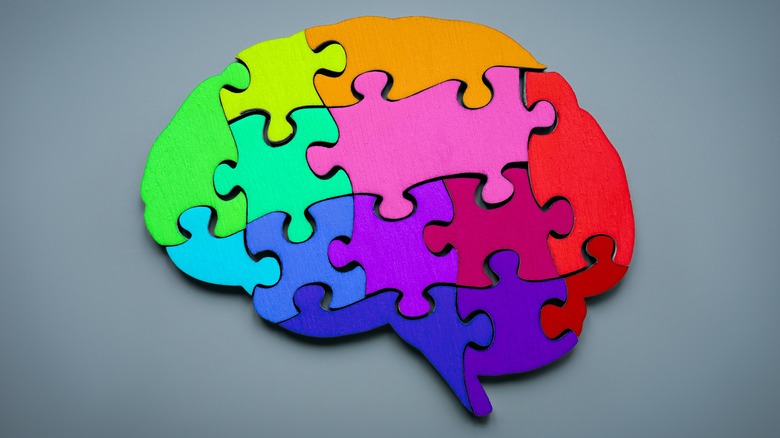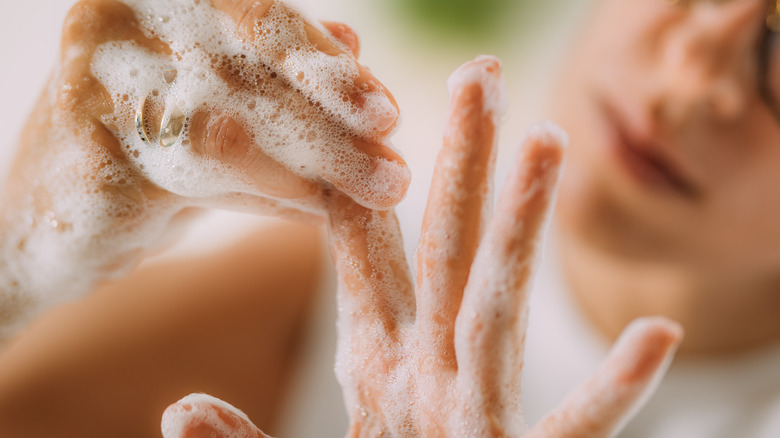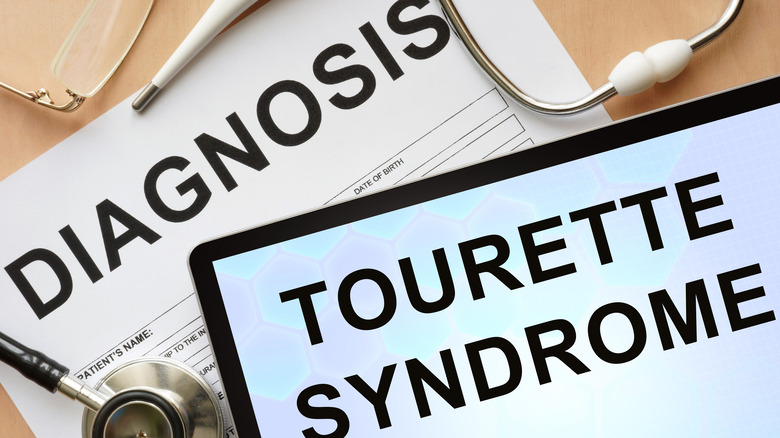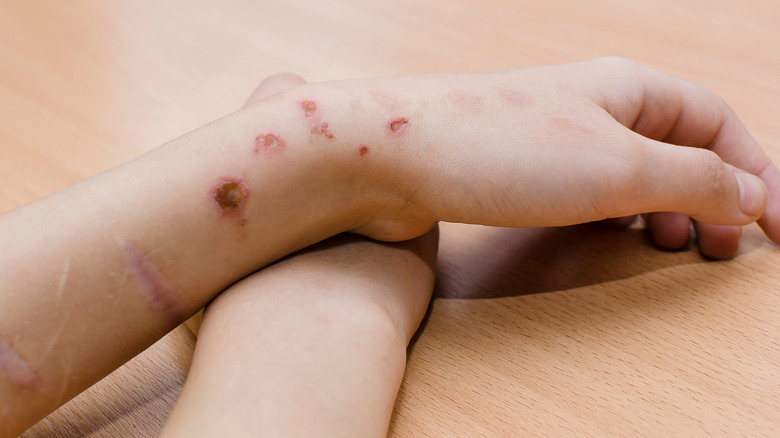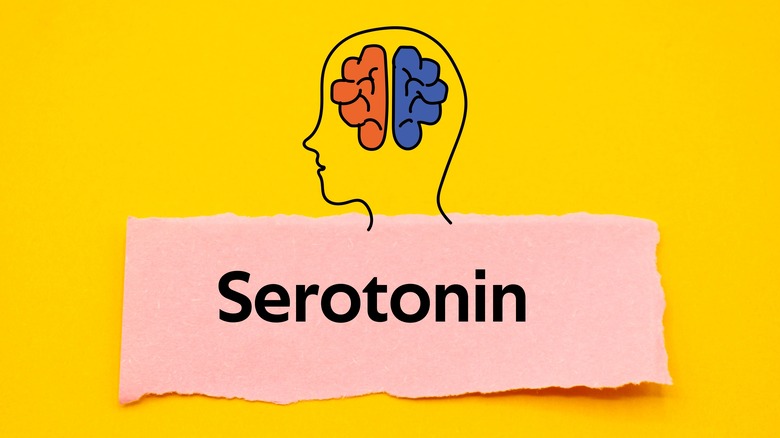Everything You Need To Know About Obsessive-Compulsive Disorder
If you or a loved one is battling obsessive-compulsive disorder (OCD), it can be very distressing and tiring (per Mind). And you are not alone: About 1% of U.S. adults — over 2.5 million people – have been diagnosed with OCD. While it might be hard to have OCD, or to see a loved one struggling with it, understanding the nature of the disorder can make it easier to cope and know how to support someone you care about (via Mind).
OCD is defined by the symptoms of obsessions, compulsions, or both. Obsessions are intrusive, upsetting, recurring thoughts that the person has difficulty controlling. Compulsions are also difficult to control for someone with OCD. Compulsions are acts that someone with OCD has to do repetitively to help alleviate their anxiety. Though OCD most often starts in late adolescence, it can occur in childhood as well (via Comprehensive Psychiatry).
A common compulsion of OCD is excessive hand washing due to fear of contamination (via Psychopathology). However, there are actually various symptom subtypes of OCD, and they can occur at different levels of severity (per Clinical Psychology Review). Furthermore, those diagnosed with OCD are also likely to be diagnosed with other mental health disorders as well (via Comprehensive Psychiatry). The good news is that OCD and other conditions can be successfully treated.
OCD can include different types of obsessions
Most obsessions in OCD can be put into one of four main categories, as described in an article in Psychopathology. The first is fear of contamination. The second is related to doubt — for instance, someone doubts they locked their doors despite checking numerous times.
The third type of obsession is taboo-related. These obsessions are often of a sexual, violent, or religious nature. Examples include thoughts of molesting children, disrespecting religious figures, and thoughts of physically hurting others. Anyone can have such thoughts, but generally they are fleeting and can be brushed off. However, someone with OCD finds them very distressing and hard to control. Those with OCD typically have no history of violence toward others, nor do they act on their thoughts (per Psychopathology). But according to a study in the Journal of Obsessive-Compulsive and Related Disorders, obsessions with taboo content tend to be more stigmatized than the other types — thus people who have them are less likely to talk about them.
The fourth type of obsession is related to symmetry and order. Being a "neat freak" does not necessarily mean you have OCD, says psychologist Jon Abramowitz (via the Anxiety & Depression Association of America). According to the Diagnostic and Statistical Manual of Mental Disorders Fifth Edition (DSM-5), in order to qualify as a symptom of OCD, the need for tidiness would have to cause extreme distress, get in the way of living an aspect of life, or take an exorbitant amount of time. For instance, someone with OCD may spend a couple of hours arranging their office before being able to sit down to work.
Compulsions in OCD can be physical or mental
Compulsive behavior is a repetitive act that the person with OCD feels they "have" to do — even if they are aware that it is not helpful — like washing hands for five hours (per an article in Neuropsychology Review). But compulsions are not just physical acts; they can also be mental, according to the DSM-5. For instance, someone might constantly pray or count in their head. Another important thing to note is that compulsions do not have to be related to obsessions. They can exist on their own based on rigid rules the person is compelled to follow.
Compulsions can be very frustrating for someone with OCD and it can be very upsetting to see a loved one doing them. Authors of a study in the Journal of Psychiatric Practice state that about 75% of people with OCD know that their compulsions are unreasonable but still cannot control them. One explanation researchers pose for the lack of control is that these people may have abnormalities in the brain circuitry that is involved in thinking and acting (per Neuropsychology Review). Dr. Tristan Gorrindo, Chief Medical Officer of Optum Behavioral Care, encourages people to remember that compulsive behavior is part of a mental health condition, not a choice or personality trait (via American Psychiatric Association).
OCD often occurs with tic disorder
According to a review published in Social Psychiatry and Psychiatric Epidemiology, because some mental health disorders can share some symptoms, it is very common for people to have multiple mental health diagnoses. In particular, tic disorders often go along with OCD. One study in Comprehensive Psychiatry found that about 12.5% of those with OCD also have a tic disorder.
Tics are sudden movements, twitches, or sounds that are repetitive and uncontrollable. According to the Centers for Disease Control and Prevention (CDC), three tic disorders appear in the DSM-5: Tourette syndrome, persistent motor or vocal tic disorder, and provisional tic disorder. While these tic disorders are distinct, there are a couple of general criteria they all share: The tics have to have started before the person turned 18 years old, and they must occur independent of another underlying medical condition that can cause tics (i.e. seizures or Huntington's disease).
OCD is often seen alongside body dysmorphic disorder
Due to unrealistic beauty standards flooding the media most of us consume daily (via Bradley University), it is common for people to be self-conscious about parts of their body (per a study in Frontiers in Psychiatry). However, being displeased with a physical characteristic does not constitute body dysmorphic disorder (BDD).
Based on DSM-5 criteria, BDD involves being obsessed with a physical attribute the person considers to be flawed but is not even observable, or appears very slight, to others. In response to this perceived "flaw," the person may engage in repetitive and time-consuming behaviors such as checking in the mirror or excessive grooming, or mental acts such as often comparing their appearance to that of others. In fact, like OCD, BDD falls in the DSM-5 disorder class of obsessive-compulsive and related disorders. One study published in Comprehensive Psychiatry found that about 8.7% of those with OCD were also diagnosed with BDD.
Self-injury and suicidality often accompany OCD
One study in the journal Comprehensive Psychiatry found that about 7.4% of people with OCD engage in self-harm, also known as non-suicidal self-injury (NSSI). According to an review in Child and Adolescent Psychiatry and Mental Health, NSSI is the intentional harming of oneself, but without suicidal intent. Examples are cutting, skin picking or scratching, burning, and interfering with the healing of wounds. And because the behavior is repetitive, some researchers think it can be considered compulsive behavior (per Behavior Modification).
OCD can also come with suicidal thoughts. A meta-analysis of 48 studies found a moderate to high correlation between OCD and thoughts of suicide (via Clinical Psychology Review). The review explains that the disorder can cause such high levels of distress, disability, and disruption to life that a person with OCD can find it unbearable. A few factors the meta-analysis found to be associated with a higher risk for suicidality were higher severity of obsessions, feelings of hopelessness, and having made suicide attempts in the past.
If you or someone you know is struggling with mental health or suicidal thoughts, please contact the Crisis Text Line by texting HOME to 741741, call the National Alliance on Mental Illness helpline at 1-800-950-NAMI (6264), or call the National Suicide Prevention Lifeline by dialing 988 or by calling 1-800-273-TALK (8255).
OCD is frequently accompanied by depression and anxiety
Thoughts of suicide among those with OCD are also associated with increased severity of depressive and anxiety symptoms (per Clinical Psychology Review). A study published in Comprehensive Psychiatry examined rates of OCD and co-occurring disorders among 3,711 adults across Brazil, Spain, India, South Africa, Japan, and Australia. This study found that 28% of those with OCD had major depressive disorder, 19% had generalized anxiety disorder, 19% had a phobia, and 18% had social phobia.
Jonathan Abramowitz, PhD, says in an article on the International OCD Foundation website that OCD is one of the most distressing and disabling mental health disorders. It can get in the way of work, school, relationships, leisure activities, and general contentment. So it is not too surprising that depression often occurs with OCD, and many people with the disorder say that their OCD symptoms began before their depressive ones, says Dr. Abramowitz. And because obsessions in OCD can be related to fear, such as fear of contamination, it makes sense that there can be an overlap with anxiety. As symptom severity increases, there is a greater likelihood for two distinct diagnoses of OCD and an anxiety disorder to be given (via Comprehensive Psychiatry). And since 75% of people with OCD know that their compulsions are irrational (per Journal of Psychiatric Practice), it is likely that they fear how others view them, a primary criterion for social phobia.
OCD can occur in children
You may not associate OCD with children. However, about half a million children in the U.S. struggle with the disorder, according to Dr. Aureen Pinto Wagner, a clinical associate professor of neurology and member of the International OCD Foundation scientific advisory board. Males with the disorder tend to develop it in childhood more than females, according to an article in Dialogues in Clinical Neuroscience. Some obsessions among children and teenagers can include worries about germs, dying, bad things happening, or doing something wrong. Some children may need things like the items placed in their lunch box to be arranged "just so," reports Dr. Wagner (via International OCD Foundation).
While all young children have routines, those with OCD have compulsions that take too much time or get in the way of their lives. Some examples of compulsive behavior among children include erasing and rewriting homework numerous times, asking the same question over and over again, or constantly checking and rechecking items in their backpacks. If these types of behaviors upset your child and interfere with their daily life, Dr. Wagner recommends talking to your child's pediatrician or a mental health professional.
There is an OCD spectrum
As is the case with many mental health conditions, there is an OCD spectrum. As explained by a study published in Comprehensive Psychiatry, someone's OCD can be at a mild, moderate, or severe level. A mild level of OCD means the person meets the minimum DSM-5 criteria for the disorder: obsessions, compulsions, or both that are agonizing and difficult to control, and which take up at least one hour of their day. An example would be someone who spends an hour checking and rechecking that they turned off all their appliances and lights before they leave for work (via New England OCD Institute).
On the severe end of the OCD spectrum would be, for instance, that someone is so afraid of contamination that after returning home, they have to wash their hands for a few hours at a time, leading to skin dryness and bleeding (via Healthline). Tristan Gorrindo writes at the American Psychiatric Association website that some people with mild OCD can improve without treatment. However, moderate or severe OCD usually needs treatment. Dr. Gorrindo also elaborates that the symptom severity can wax and wane. There can be periods when symptoms are better and others when they are worse, such as during highly stressful times.
What causes OCD?
Research hasn't yet identified one exact cause of OCD, according to Johns Hopkins Medicine. The National Institute of Mental Health (NIMH) shares that brain structure might be related to OCD, but scientists don't yet know exactly what that connection is. Some studies have found a link between OCD and childhood trauma, but more research is needed there as well. The third main predictor of OCD is genetics. Tristan Gorrindo, M.D. says in an article on the American Psychiatric Association website that OCD is more common among people who have a family member with the disorder. According to the NIMH, twin and family studies have found that people are at higher risk of developing OCD if they have a parent, child, or sibling with the disorder.
One type of obsessive-compulsive disorder is caused by the use of a substance (via PsychDB). In this case, obsessions or compulsions occur when a person is under the influence of, or in withdrawal from, a substance or medication that is capable of producing the symptoms. The diagnosis would not be OCD exactly but rather, a Substance/Medication-Induced Obsessive-Compulsive and Related Disorder, and a couple substances that could cause this disorder are cocaine and stimulants like amphetamine.
A trained therapist diagnoses OCD
There is no actual "test" that you can take that definitively tells you whether or not you have OCD. As stated by Dr. Jonathan S. Abramowitz on the International OCD Foundation website, assessment should be done by a skilled mental health clinician. Some clinicians may have you complete a questionnaire or screener for OCD, however this alone does not give you a clear-cut diagnosis, according to an article in Journal of Anxiety Disorders. Rather, if you get a positive screen, that just means that it is recommended that you be assessed further for OCD. And depending on your health status, symptoms, and history, your primary care provider may want to do a blood test to see if the symptoms could be caused by a medication you are taking or by another health condition (per Medline Plus).
An interview with a mental health clinician is needed for diagnosis because the clinician's observations and judgments are important to the overall assessment, as stated in a paper published in Journal of Central Nervous System Disease. Furthermore, they gather information about you, your history, your life experiences, and perhaps an OCD questionnaire, and synthesize it all to develop a picture of what is going on. This is especially important because OCD shares attributes with other disorders, and the clinician considers those when making as accurate a diagnosis, or diagnoses, as possible.
Psychotherapy is effective for treating OCD
Treatment of OCD can include psychotherapy, medication, or both (via International OCD Foundation). Cognitive behavioral therapy (CBT) is a common type of therapy that research studies have found to be effective for various mental health conditions, including OCD, depression, and anxiety disorders. CBT, per the American Psychological Association, examines how your thoughts, behaviors, and emotions all relate to each other. The idea is that by changing thinking or behavioral patterns to more helpful ones, distress can be reduced.
One specific form of CBT that especially works for treating OCD is exposure and response prevention (ERP). Some research has found that about 67% of patients who tried this form of therapy improved, and about 33% achieved complete remission from symptoms (per Indian Journal of Psychiatry). ERP therapy trains you to "face your fears" as a way to overcome them (per F1000Prime Reports). With your therapist present, you would face a situation that triggers worry, such as touching a public door knob. With support and reassurance from your therapist, you would try to hold the door knob until your anxiety significantly reduces. Facing your fears directly might seem scary — and ERP can be challenging — but you will start with your therapist present and with a situation that causes you the least amount of anxiety (via International OCD Foundation). Then you slowly work your way up, at your own pace, to the highest anxiety-provoking situation for you. ERP often also includes exposure exercises as homework for you to do in between therapy sessions (per F1000Prime Reports).
Medication to treat OCD
OCD cannot be cured, but can be successfully controlled with treatment, including medication. Adults who benefit from the medication see their symptoms reduced by as much as 60% (via International OCD Foundation). Medications typically prescribed are antidepressant medications that also work for OCD — specifically, selective serotonin reuptake inhibitors (SSRIs). Examples are the commonly known brand names Prozac, Zoloft, and Paxil. Scientists do not know the exact mechanism by which they work. They do affect levels of serotonin, a chemical in your brain that acts like a messenger. Scientists speculate that a boost in serotonin might help neurons in your brain to communicate better with each other and thus reduce symptoms and improve overall functioning.
With children, experts recommend medication if the OCD is moderate or severe, and only after trying ERP first (per International OCD Foundation). The SSRIs that are approved by the Food and Drug Administration (FDA) to treat children are the brands Prozac, Luvox, Zoloft, and Lexapro. For both adults and children, the best results occur when you take medication regularly as prescribed by your doctor. Sometimes a change in dose or the medication itself is needed to achieve the best results (per International OCD Foundation). And in some cases, particularly with severe OCD, therapy combined with medication is likely the most effective treatment (via The Lancet Psychiatry).
OCD is different from obsessive-compulsive personality disorder
Obsessive-compulsive personality disorder (OCPD) is different from OCD. With OCD, obsessions and compulsions are specific worries that cause the person a lot of distress. A person with OCPD, on the other hand, is very preoccupied with perfectionism and orderliness in almost all of their relationships and all parts of their life. They are inclined to control others, which is damaging to their interpersonal relationships. And a person with OCD is likely to understand that their obsessions or compulsions are irrational. However, someone with OCPD tends to think that their way of doing things is the "right way" and should be employed by others as well (per International OCD Foundation). They also are not likely to believe they need treatment because they think they are fine and it is others who need to adhere to their rules.
According to International OCD Foundation, no cause of OCPD has been found, but one study in The American Journal of Geriatric Psychiatry suggests that experiencing childhood adversities increases the likelihood of developing personality disorders. Diagnosing a personality disorder can be challenging — a therapist would need to work with the person for an extended period of time to see if their symptoms and behaviors are consistent and pervasive. The Minnesota Multiphasic Personality Inventory (MMPI) can aid with diagnosis. If a person with OCPD is motivated to change, therapy can be beneficial. One small study in the journal Behaviour Research and Therapy suggests that group therapy using CBT can reduce the severity of symptoms.

